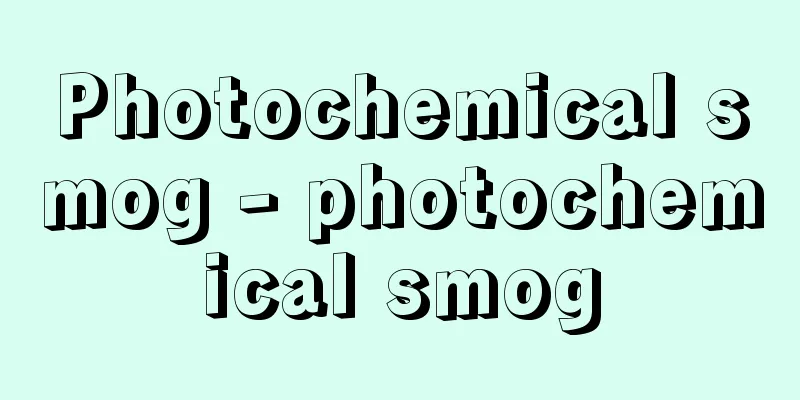Photochemical smog - photochemical smog

|
Smog is generated by photochemical reactions between hydrocarbons and nitrogen oxides in polluted air. It is sometimes called Los Angeles-type smog because it was first discovered in Los Angeles, USA. Among nitrogen oxides, nitrogen dioxide (NO2 ) absorbs sunlight and dissociates into nitric oxide and oxygen atoms, and most of these oxygen atoms combine with oxygen molecules to become ozone. It is believed that various pollutants are generated by complex reactions between oxidizing substances such as ozone and nitrogen oxides and hydrocarbons. Pollutants include peroxides such as PAN (peroxyacetyl nitrate), acrolein, acetaldehyde, and alkyl nitrates, and the highly oxidizing substances that are produced when these substances undergo complex chemical reactions are collectively known as oxidants. There are still many unknowns about the smog particles that cause impaired visibility, but they are thought to be condensed high molecular weight, refractory components, or polluting components adsorbed onto the surfaces of other airborne particles. There are still many unknowns about the mechanism of generation and the substance of the particles, and research is yet to begin. [Yamazaki Akira] weatherIt is called smog because it reduces visibility to some extent, but the smog in this case does not normally include natural fog. Emitted gases change in the atmosphere, so the degree of change varies depending on the weather at the time. The legal environmental standard for photochemical oxidants is 0.06 ppm or less per hour. In cities, when the concentration of photochemical smog becomes high, warnings and alerts are issued and measures are taken. These levels are set by prefectural ordinances based on the Air Pollution Control Act, but a warning level of 0.12 ppm per hour and an alert level of 0.4 ppm are generally adopted. [Masaji Ota] "Basic Chemistry for Environmental Understanding" by J.W. Moore and E.A. Moore, translated by Shinji Iwamoto (1980, Tokyo Kagaku Dojin) [Reference] | |©Shogakukan "> Mechanism of photochemical smog generation Source: Shogakukan Encyclopedia Nipponica About Encyclopedia Nipponica Information | Legend |
|
汚染した大気中の炭化水素と窒素酸化物とから、光化学反応によって生成するスモッグ。最初アメリカのロサンゼルスでみいだされたためにロサンゼルス型スモッグとよばれることもある。窒素酸化物のうち、二酸化窒素NO2は太陽光線を吸収して、一酸化窒素と酸素原子に解離するが、この酸素原子の大部分は酸素分子と結合してオゾンとなる。このオゾンや窒素酸化物などの酸化性物質と、炭化水素との間の複雑な反応から、種々の汚染物質が生じるものと考えられている。 汚染物質のなかには、PAN(ペルオキシアセチルナイトレート)などの過酸化物や、アクロレイン、アセトアルデヒド、硝酸アルキルエステルなどが認められているが、これらの物質が、複雑な化学変化をおこして生じた、強い酸化性のある物質がオキシダントと総称される。視程障害の原因となるスモッグ粒子についてはまだ未解明の部分が多いが、高分子量の難揮発性成分の凝縮したもの、あるいは、ほかの浮遊粒子の表面に汚染成分が吸着したものなどと考えられている。発生機構、本体などにはまだ不明の点が多く、研究はこれからである。 [山崎 昶] 気象多少視程を悪くするのでスモッグというが、この場合のスモッグには自然の霧は普通含まれない。排出されたガスは大気中で変質するから、そのときの気象によって変質の度合いが異なる。法令で定められている光化学オキシダントの環境基準は1時間値0.06ppm以下である。都市では光化学スモッグの濃度が高くなると、注意報や警報が出され対策がとられる。それらのレベルは大気汚染防止法に基づいて都道府県条例で定められるが、一般には注意報レベルとして1時間値0.12ppm、警報レベルとして0.4ppmが採用されている。 [大田正次] 『J・W・ムーア、E・A・ムーア著、岩本振武訳『環境理解のための基礎化学』(1980・東京化学同人)』 [参照項目] | |©Shogakukan"> 光化学スモッグ発生のメカニズム 出典 小学館 日本大百科全書(ニッポニカ)日本大百科全書(ニッポニカ)について 情報 | 凡例 |
>>: Merit and demerit - Koukakaku
Recommend
Rundhorizont
…Usually it is made of a vertical curved surface ...
Yelu Chucai - A man of great skill
A meritorious official in the early Mongol Empire...
spermata
…He is also famous as a teacher and friend of the...
Dissected alluvial fan - Dissected alluvial fan
…In arid and semi-arid regions, the production of...
Genshu Katakura - Genshu Katakura
An obstetrician in the late Edo period. Born in T...
Ashio Mine Riot
A riot by miners broke out at the Ashio Copper Min...
Trypanosoma
Trypanosoma is a genus of Trypanosoma in the orde...
Okinawan stick insect - Okinawan stick insect
…About 2,000 species are known from around the wo...
Inanna
…the representative Babylonian goddess. In Sumer ...
Interstellar molecules
Molecules that exist in interstellar space. The d...
Wajinchi - Japanese land
Also called Shamo-chi or Ningen-chi, this area wa...
Oceanic noise
When a typhoon or strong low pressure system is o...
Shore lark (Hamahibari) - Shore lark (English spelling)
A passerine bird of the lark family. Total length ...
zarabanda
…Though the origins of dance in Spain are very ol...
Ebina Clan
A medieval samurai family whose main territory was...

![Kasukabe [city] - Kasukabe](/upload/images/67cb33dcd1467.webp)







